
During the past 20 years of writing the Growing in the Green column, I have written about four greenhouse operations and this is my fifth.
During the past 20 years of writing the Growing in the Green column, I have written about four greenhouse operations and this is my fifth.
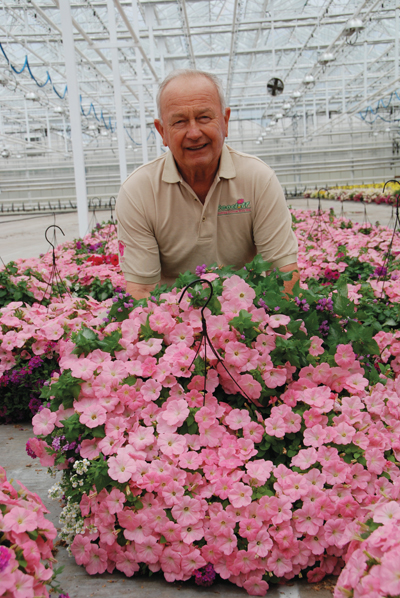
|
|
| Walter Ondejko | |
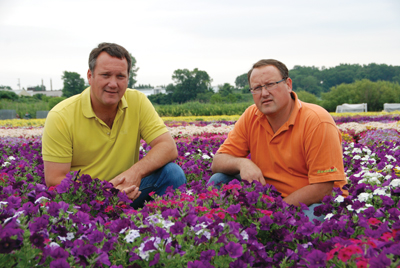
|
|
| brothers John (general manager) and Bob (operations manager) Ondejko. | |
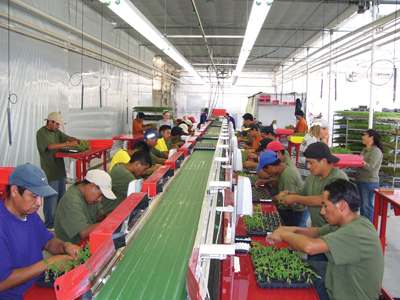
|
|
| A view of the sticking line. | |
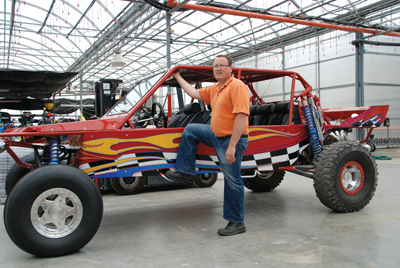
|
|
| How Bob Ondejko unwinds away from the farm. | |
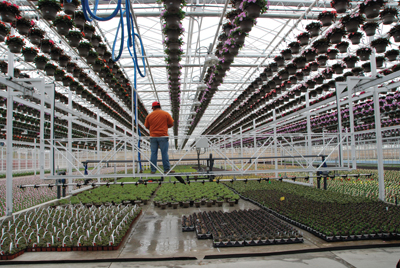
|
|
| A grower on the boom trolly spot watering using the boom. | |
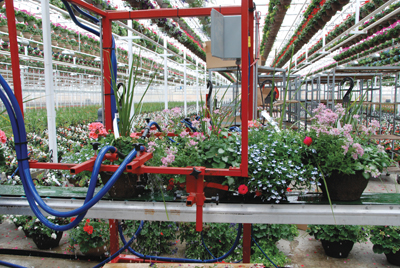
|
|
| Hanging baskets shipping line watering station. | |
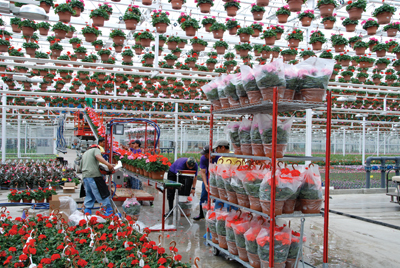
|
|
| Hanging baskets shipping line. | |
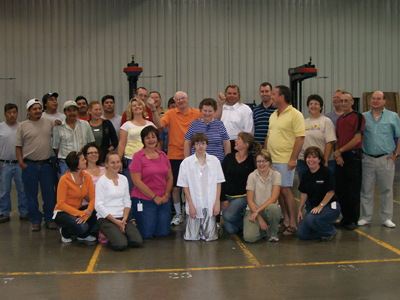
|
|
| Some of the staff take time for a break … and a photo. Advertisement
|
In each instance, the operations have been family operated with agriculture field crops – a background of fruits and vegetables – that then shifted to greenhouse production.
The Seacliff operation started with Walter Ondejko when he arrived with his parents in 1944 from Czechoslovakia. Escaping the communist regime, they left in the middle of the night, leaving everything behind to start a new life in the land of opportunity – Canada. The Ondejko family started their Canadian life in Leamington where Paul Ondejko bought a farm and grew field corn for two years, then bought a peach farm and ran that for six years, selling the produce to a buyer in Michigan.
FIRST GREENHOUSE IN 1956 GREW BURPEE CUCUMBERS
From 1952 to 1956, three farms were operated. In 1956, the Ondejko family started a 60,000-square-foot greenhouse where, for nine years, he grew Burpee cucumbers on a substrate with manure being the main ingredient.
In 1965, Walter Ondejko erected a greenhouse he purchased in Chicago and, in the same year, Seacliff Farms Incorporated was formed.
During all this expansion and hard work, Walter married Mitzi in 1955, and the Ondejko family began their own expansion with five boys (Mark, Tim, Steve, John and Bob) and three girls (Debbie, Dian and Lisa).
All family members helped on the farm from when they began walking and continuing with working after school hours.
In 1966, Walter built another 15,000-square-foot greenhouse with $2,000 he borrowed from the Royal Bank. All this was going on along with work on the 120 acres of field tomatoes, which were hand-picked as a mechanized picking process didn’t arrive until the early 1980s.
In the early 1970s, Walter purchased four acres from another grower. He built on two acres and sold the other two.
In 1984, John joined the business full time, just when the business was looking to diversify.
WORK WITH ZONAL GERANIUMS BEGAN IN 1985
In 1985, Tim Ondejko was working for Ball Superior Company, where he introduced John to Jeff Lamb, the Ball Superior manager at that time. Ball Superior was looking for a zonal geranium propagator and supplier at the time John wats looking to diversify. They came to an agreement that required John to learn geranium propagation and production, so he hooked up with Bill Miller, a grower in Eden, New York. John finished his apprenticeship in 10 days at the Miller farm.
Seacliff obtained geranium stock and began producing rooted cuttings that they sold through Ball Superior. They dedicated one acre to geranium production for five years. John took the initiative to calculate the cost and profit just from the geraniums and soon realized he should venture into growing finished bedding plants and poinsettias.
In 1988 Bob got into the business full time, right after high school.
The years 1992 and 1993 saw the first expansion of 100,000 square feet of greenhouse in which poinsettias, Easter lilies, hydrangeas and bedding plants were produced.
In 1995, the dormant hydrangea program started and has now expanded to over 10 acres of outdoor hydrangea production with the ability to cool them in a state-of-the-art 35,000-square-foot cooler. In the same year, another 100,000 square feet was added to the operation and this expansion was repeated in 1996 and 1998 with 100,000 square feet added each time.
VEGETABLE TRANSPLANT BUSINESS BEGAN IN 1998
In 1998, Seacliff started growing vegetable transplants to fill the low-production period experienced mainly in December and January.
The year 2006 heralded a new range of adjusted Venlo-style greenhouses with all the ingredients required to produce premium vegetable transplants and top-quality bedding plants. High-intensity lights, double curtains, heated flood floors, totally computerized booms, and a new heating system added to the previous system were many of the highlights of the new greenhouses. After purchasing an adjacent farm and its greenhouses, Seacliff grew to 25 acres under cover and 15 acres of outdoor production, along with a 35,000-square-foot cooler and 50,000 square feet of shipping area.
I hasten to say that any expansion was based on sales demand. Greenhouse area was rented for a short period to make sure the extra demand in sales was concrete for an extended period and not just the one year.
As much as John and Bob like the business, one thing they never lost sight of is that any project, expansion or customer taken on must make a profit. This is true with every business and getting a business to the point of profitability can be accomplished in many ways but the following comments are, according to John and Bob, basic facts.
IF END USERS ARE HAPPY, THEY WILL BUY MORE PLANTS
If demand for a product is there, how can we get a share of the demand, how can we produce it at the most effective cost, and how can we enhance it to add value to the product so we can improve our margins? How can we help our customer and the end consumer, because if the end user of our product is happy and satisfied, then he or she will buy more, which gives our customer a better profit margin and, ultimately, will make us successful and profitable.
To produce any crop, Seacliff has predetermined steps to be taken to accomplish the job. Almost every crop is its own project where every step is pre-recorded and shared with every person involved in that crop/project from planning to ordering plant material, hard goods, growing location and amounts of production. Production amounts are based on sales demand and never on production capacity.
Their philosophy is, “let’s grow what we can sell/sold rather than try to sell what we can grow/grew.”
As John says, the employees need to know what is required from them and what is coming their way. Communication is a vital part of the organization, and with the computer age, this is much easier when technology is used with all its potential. Knowing the importance of this, Seacliff has a full-time computer programmer on staff with the mandate to facilitate any new computerized programs or to come up with programs to make any job easier, faster and more efficient.
THE IMPORTANCE OF MECHANIZATION
The next step in making everything click properly is mechanization, with a vision that every machine, process, and structure will pay back in three years or less. Some of the projects are for heat efficiency, others for labour efficiency, and some are necessary just to get the work done for the required period of time. To accomplish this, Bob takes the lead and has the passion to find ways to meet the efficiency required.
To cover all the machinery, equipment and processes and how they help the overall process would require three or four articles to explain in detail, so I took some pictures of some of the machinery and structures and, hopefully, with my short explanations, you will get the picture.
Right after the second 100,000-square-foot expansion, both John and Bob realized that expansion without building a team is doomed to fail. So the restructuring of the various departments – and looking for qualified employees who are skilled and, more importantly, share their business attitude – was the hardest part. But when you see the whole company working as a team toward the same goal, then you can say the goal is achieved. Seacliff strongly believes that their biggest assets are the employees.
I have known the Ondejko family since I was with Fernlea Flowers and visited Seacliff to look at some geraniums. John and I argued about a one-cent difference in price on a 4” geranium. I started to know them much better when I began working with them as a consultant in 1990 when they became my second customer!
ALWAYS LOOK FORWARD TO OUR CONSULTATIONS
When John began to shift from growing only geraniums to bedding plants, poinsettias, lilies and hydrangeas, there was a lot to learn, implement and improve. I have welcomed many more clients since 1990 and with every client there is a learning curve for me and for them to ensure we are on the right track to accomplish our goals. I have to say that, with John and Bob, there is a very pleasant environment for working on new crops, improving existing ones, discussing new ideas and, by the end of the day, always coming up with a plan that is applied without delay or hesitation. I always look forward to our consultations.
Seacliff is a family operation that started with Walter Ondejko, the father, then John and Bob took over but, to this day, Walter is there every day offering his help whenever they need it and making sure they are on time to work!
Though the Ondejko family is much larger now under the Seacliff umbrella, the family spirit, concern, love and care for every employee can still be felt in every transaction and at every request.
The Ondejkos’ hard work, generosity and care for others is a special thing that can be seen in many family-run greenhouse operations that I see firsthand. As an industry, I hope and pray that we never lose sight of the importance of family, especially in the greenhouse industry.
Melhem Sawaya of Focus Greenhouse Management is a consultant and research co-ordinator to the horticultural industry. Comments on this or any other article are always welcome; please e-mail mel@focusgreenhousemanagement.com, or visit www.focusgreenhousemanagement.com or www.sawayagardentrials.ca
Print this page